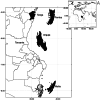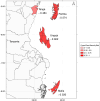A new framework on climate-induced food-security risk for small-scale fishing communities in Tanzania
- PMID: 39429539
- PMCID: PMC11489249
- DOI: 10.1007/s12571-024-01472-x
A new framework on climate-induced food-security risk for small-scale fishing communities in Tanzania
Abstract
Food insecurity is a pressing issue facing our world, particularly affecting coastal communities who rely on marine resources. The problem is further compounded by the rapidly changing climate, a deteriorating environment and growing human populations. It is essential to evaluate this issue accurately to reduce risk and improve the situation of coastal communities, especially in countries with less socioeconomic development. To this end, we develop a food security social-ecological risk assessment framework for developing communities in coastal areas of the Western Indian Ocean facing a changing environment. The framework integrates local ecological knowledge, expert scientific opinion, survey data, and satellite sea surface temperature (SST) and chlorophyll-a observation. We conducted a local-scale case study in four regions in Tanzania; Mafia, Pemba, Tanga, and Unguja, revealing that they face moderate to high risk levels of food insecurity. The highest risk was observed in the island communities of Pemba and Unguja, while the communities of Mafia and Tanga had the lowest risk due to lower exposure and sensitivity to climate change. Our results show that recognizing the key differences across risk components is crucial in identifying effective intervention strategies for local practitioners. This study highlights the need for detailed assessments to provide accurate information on local-scale food security dynamics, specifically when assessing impacts induced by environmental and climatic changes.
Supplementary information: The online version contains supplementary material available at 10.1007/s12571-024-01472-x.
Keywords: Climate change; Food security; Risk assessment; Small-scale fisheries; Western Indian Ocean.
© The Author(s) 2024.
Conflict of interest statement
Competing interestThe authors have no competing interests to declare that are relevant to the content of this article.
Figures







References
-
- Allison, E. H., Perry, A. L., Badjeck, M. C., Adger, W. N., Brown, K., Conway, D., Halls, A. S., Pilling, G. M., Reynolds, J. D., Andrew, N. L., & Dulvy, N. K. (2009). Vulnerability of national economies to the impacts of climate change on fisheries. Fish and Fisheries,10(2), 173–196.
-
- Aswani, S., Howard, J. A. E., Gasalla, M. A., Jennings, S., Malherbe, W., Martins, I. M., Salim, S. S., Van Putten, I. E., Swathilekshmi, P. S., Narayanakumar, R., & Watmough, G. R. (2018). An integrated framework for assessing coastal community vulnerability across cultures, oceans and Scales. Climate and Development,11(4), 365–382.
-
- Barange, M., Bahri, T., Beveridge, M. C., Cochrane, K. L., Funge-Smith, S., & Poulain, F. (2018). Impacts of climate change on fisheries and aquaculture. United Nations’ Food and Agriculture Organization,12(4), 628–635.
-
- Benansio, J. S., & Jiddawi, N. (2016). Investigating changes in fish biodiversity in coastal villages of Zanzibar Island. Tanzania. International Journal of Fisheries Aquaculture,8(12), 117–125.
LinkOut - more resources
Full Text Sources
